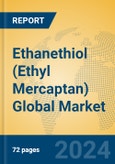Currently, ethanethiol supply faces persistent tightness, constraining downstream production of agrochemicals like clethodim, which boasted a global market size of approximately USD 380 million in 2020. However, upcoming projects, such as Gansu Runtaihe Technology Chemical’s 6,000-ton ethanethiol facility in China (part of a 10,000-ton thiol series project launched in 2023) and Xinjiang Xingfa Chemicals’ 3,000-ton plant (announced in 2024), signal potential relief. The market is driven by steady demand from gas safety applications and agriculture, alongside efforts to expand capacity and address supply chain bottlenecks.
Market Size and Growth Forecast
The global ethanethiol market is estimated to reach USD 80 million to USD 90 million by 2025, with a projected compound annual growth rate (CAGR) of 5% to 6% through 2030, fueled by growing gas infrastructure and agrochemical needs.Regional Analysis
Asia Pacific anticipates the highest growth rate, ranging from 6% to 8%, led by China and India. China’s expanding gas distribution networks and agrochemical sector, bolstered by new production facilities, drive demand, while India’s agricultural growth supports ethanethiol use in pesticides. North America expects growth of 4% to 5%, with the United States as a key consumer due to its extensive natural gas industry and established chemical manufacturing base.Europe, projected at 4.5% to 6%, sees steady demand in France and Germany, where gas safety regulations and agrochemical production sustain ethanethiol use. South America anticipates growth of 3% to 4.5%, with Brazil leveraging ethanethiol for agriculture, though limited by industrial scale. The Middle East and Africa, with growth at 3.5% to 5%, rely on gas odorant applications in the UAE and South Africa, tied to energy sector development.
Application Analysis
- Agrochemical Intermediates: Expected to grow at 5.5% to 7%, ethanethiol is crucial for synthesizing herbicides like clethodim, with trends focusing on addressing supply constraints to meet rising food production needs.
- Gas Odorant: Projected at 4.5% to 6%, ethanethiol’s role in gas safety remains steady, with demand linked to expanding energy infrastructure and regulatory mandates.
- Others: Anticipated at 3% to 5%, this includes niche uses like chemical synthesis, with moderate growth tied to industrial applications.
Key Market Players
- Chevron Phillips Chemical: A U.S. leader, this firm excels in ethanethiol production, serving gas and agrochemical markets with advanced technology.
- Arkema: A French giant, Arkema dominates globally, offering high-quality ethanethiol for diverse industrial applications.
- Anqing Changhong: A Chinese player, Anqing Changhong focuses on ethanethiol for regional agrochemical and gas sectors, expanding capacity.
Porter’s Five Forces Analysis
- Threat of New Entrants: Moderate. High technical and capital barriers limit entry, though new projects in China signal potential competition.
- Threat of Substitutes: Low to Moderate. Alternative odorants exist, but ethanethiol’s cost-effectiveness and efficacy maintain its dominance.
- Bargaining Power of Buyers: Moderate. Gas utilities and agrochemical firms have some leverage due to concentrated supply, though limited alternatives temper this.
- Bargaining Power of Suppliers: High. Few producers control raw materials like ethanol and hydrogen sulfide, strengthening supplier influence.
- Competitive Rivalry: High. Chevron Phillips and Arkema compete intensely on quality, capacity, and pricing, driving innovation.
Market Opportunities and Challenges
Opportunities
- New Capacity: Projects in China enhance supply, easing agrochemical production constraints.
- Gas Infrastructure Growth: Expanding energy networks boost odorant demand.
- Agricultural Demand: Rising food needs increase ethanethiol use in pesticides.
- Technological Innovation: Improved production processes enhance efficiency.
- Emerging Markets: Industrialization in Asia and Africa opens new avenues.
Challenges
- Supply Tightness: Current shortages limit downstream output.
- Environmental Regulations: Stricter sulfur emission rules increase compliance costs.
- Raw Material Volatility: Fluctuations in ethanol and sulfur prices affect profitability.
- Substitute Development: Emerging odorants pose long-term risks.
- Logistical Constraints: Transporting flammable ethanethiol challenges supply chains.
This product will be delivered within 1-3 business days.
Table of Contents
Companies Mentioned
- Chevron Phillips Chemical
- Arkema
- Anqing Changhong








